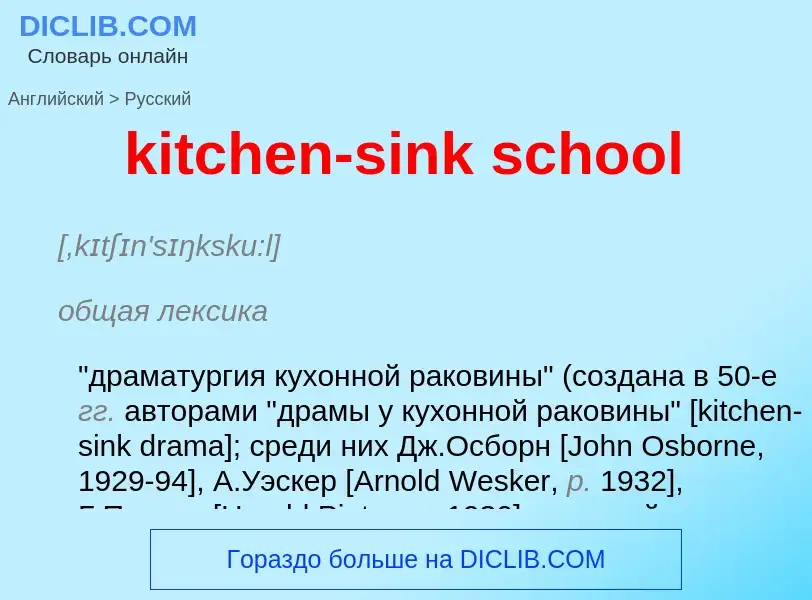Translation and analysis of words by ChatGPT artificial intelligence
On this page you can get a detailed analysis of a word or phrase, produced by the best artificial intelligence technology to date:
- how the word is used
- frequency of use
- it is used more often in oral or written speech
- word translation options
- usage examples (several phrases with translation)
- etymology
kitchen-sink school - translation to English
[,kɪtʃɪn'sɪŋksku:l]
общая лексика
"драматургия кухонной раковины" (создана в 50-е гг. авторами "драмы у кухонной раковины" [kitchen-sink drama]; среди них Дж.Осборн [John Osborne, 1929-94], А.Уэскер [Arnold Wesker, р. 1932], Г.Пинтер [Harold Pinter, р. 1930]; для этой драматургии, особ. на первом этапе, характерны элементы критики современного буржуазного общества)
натурализм, бытовизм
[,kɪtʃɪn'sɪŋk,drɑ:mə]
общая лексика
"драма у кухонной раковины" (натуралистическая бытовая пьеса об обыденных, часто неприглядных, сторонах жизни; такие пьесы были популярны в 50-е гг. после постановки драмы Дж.Осборна [John Osborne] "Оглянись во гневе" ["Look Back in Anger"], где почти всё действие происходит на кухне)
бытовая пьеса
синоним
Definition
Wikipedia

Kitchen sink realism (or kitchen sink drama) is a British cultural movement that developed in the late 1950s and early 1960s in theatre, art, novels, film and television plays, whose protagonists usually could be described as "angry young men" who were disillusioned with modern society. It used a style of social realism which depicted the domestic situations of working-class Britons, living in cramped rented accommodation and spending their off-hours drinking in grimy pubs, to explore controversial social and political issues ranging from abortion to homelessness. The harsh, realistic style contrasted sharply with the escapism of the previous generation's so-called "well-made plays".
The films, plays and novels employing this style are often set in poorer industrial areas in the North of England, and use the accents and slang heard in those regions. The film It Always Rains on Sunday (1947) is a precursor of the genre and the John Osborne play Look Back in Anger (1956) is thought of as the first of the genre. The gritty love-triangle of Look Back in Anger, for example, takes place in a cramped, one-room flat in the English Midlands. Shelagh Delaney's 1958 play A Taste of Honey (which was made into a film of the same name in 1961) is about a teenage schoolgirl who has an affair with a black sailor, gets pregnant and then moves in with a gay male acquaintance; it raises issues such as class, ethnicity, gender and sexual orientation. The conventions of the genre have continued into the 2000s, finding expression in such television shows as Coronation Street and EastEnders.
The term "Kitchen Sink School" was first used in the visual arts, where the art critic David Sylvester used it in 1954 to describe a group of painters who called themselves the Beaux Arts Quartet, and depicted social realist-type scenes of domestic life.

![''[[A Taste of Honey]]'' is an influential "kitchen sink drama". In this photo of the 1960 Broadway production, [[Joan Plowright]] plays the role of Jo, a 17-year-old schoolgirl who has a love affair with a black sailor (played by [[Billy Dee Williams]]). ''[[A Taste of Honey]]'' is an influential "kitchen sink drama". In this photo of the 1960 Broadway production, [[Joan Plowright]] plays the role of Jo, a 17-year-old schoolgirl who has a love affair with a black sailor (played by [[Billy Dee Williams]]).](https://commons.wikimedia.org/wiki/Special:FilePath/Billy Dee Williams Joan Plowright A Taste of Honey Broadway 1960.jpg?width=200)
